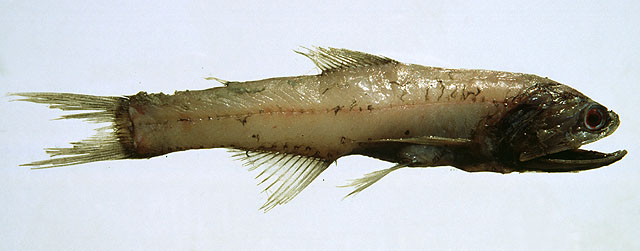| Myctophidae (Lanternfishes), subfamily: Lampanyctinae |
| 30 cm SL (male/unsexed) |
|
bathypelagic; depth range 0 - 1192 m, oceanodromous |
| Eastern Atlantic: strays as far north as Dohrn Bank (off East Greenland) and off northwest Iceland, from British Isles to Mauritanian Upwelling Region including the Mediterranean (Ref. 4479). Western Atlantic: as shallow as 46 m in Ungava Bay, Canada, in slope water region (Ref. 5951). |
|
Dorsal soft rays (total): 13-14; Anal soft rays: 16-18. Distinguished from other species of Lampanyctus by the pattern of its photophores and by its short pectoral fins located just behind gill opening (Ref. 5571). Photophores along ventral post-anal region (AO): 6 (7) + 8 (7-9) = 14 (13-16) (Ref. 4775). |
| High-oceanic, between 700-1,000 m during the day (with juveniles in the upper 200 m) and 45-250 m and 4000-1,000 m at night (Ref. 4479). Depth range from 318-1192 m in the eastern Ionian Sea (Ref. 56504). Epipelagic to bathypelagic, feeds on zooplankton (Ref. 58426). Catches of lanternfishes off the west coast of South Africa: 1,134-42,560 mt (Ref. 5571). Minimum depth from Ref. 58018. |
|
(Ref. 96402)
|
| harmless |
|
Source and more info: www.fishbase.org. For personal, classroom, and other internal use only. Not for publication.
Page created by Jen, 05.08.02,
php script by kbanasihan 06/09/2010 ,
last modified by
dsantos, 20/08/10

